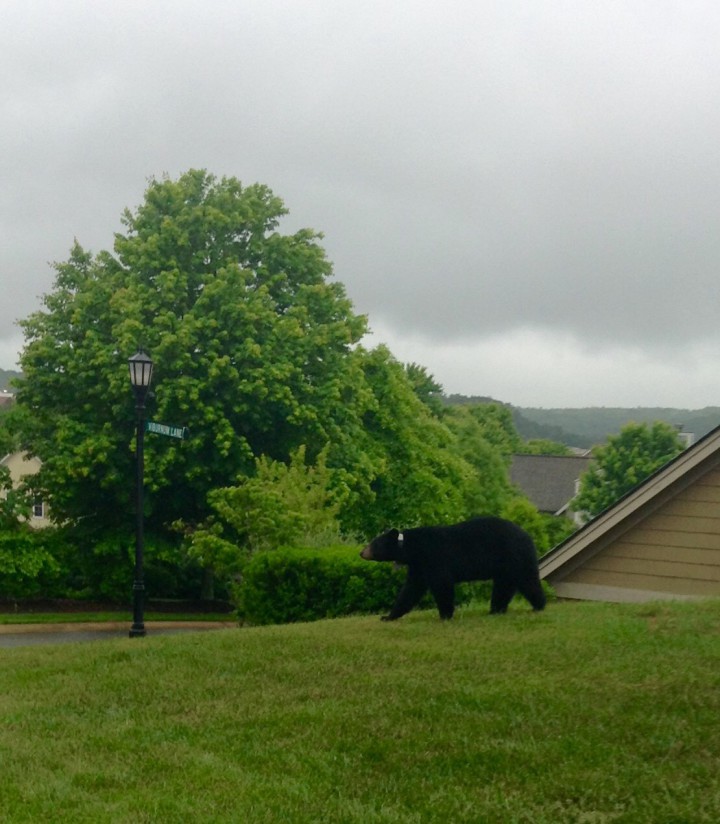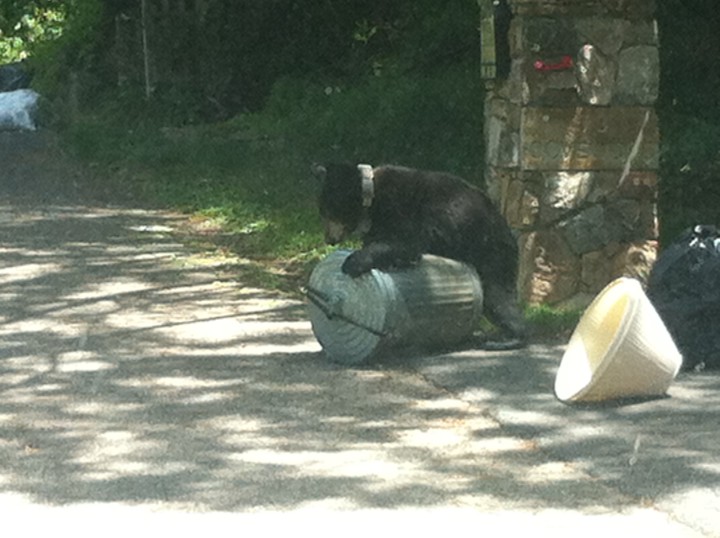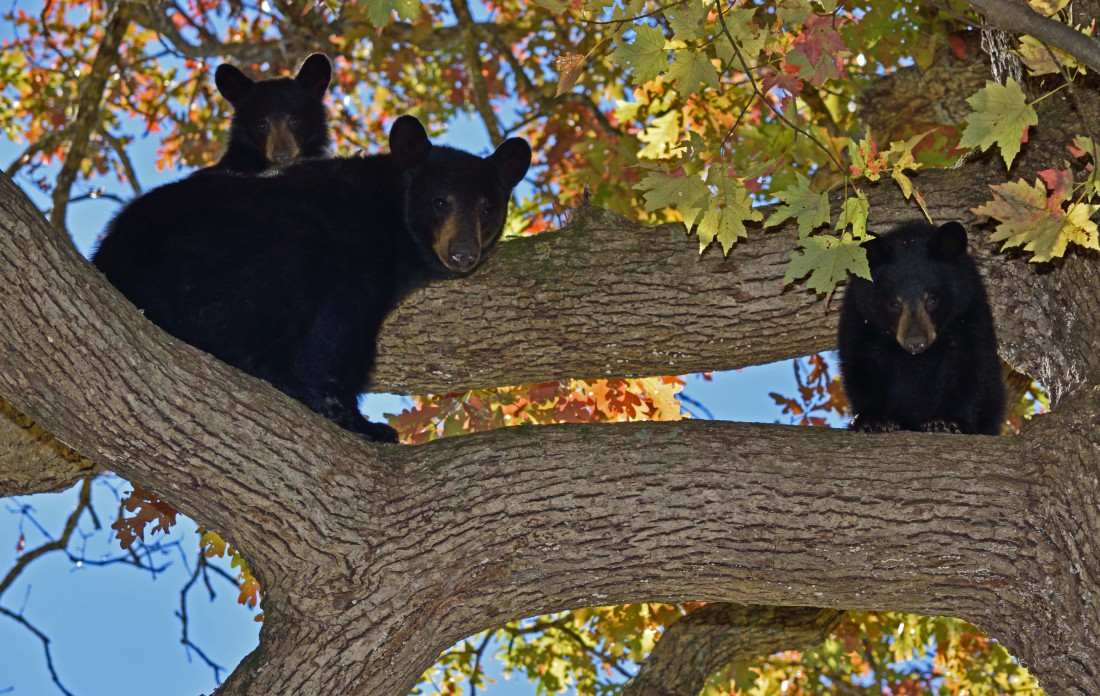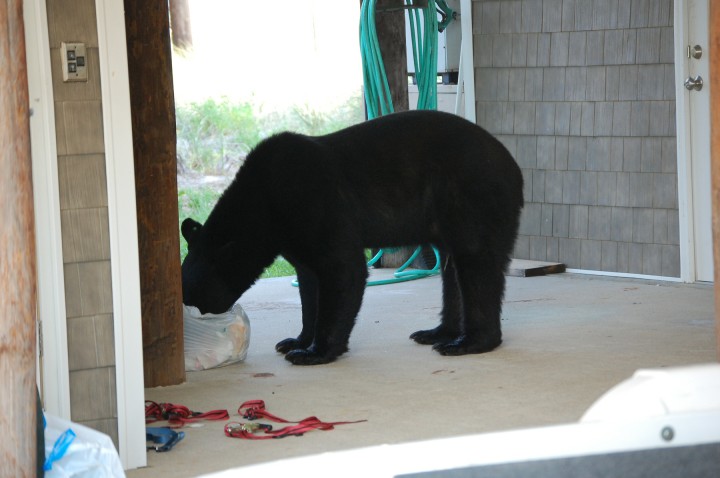Armed with a catch pole, Sgt. Jim Robinson of the Buncombe County Sheriff’s Office Animal Control unit, once single-handedly removed a black bear from inside a home. “That was exciting,” he says. “It wasn’t a tremendously large bear — probably 100 pounds.”
Over the years, Robinson has encountered a handful of these unwanted house guests. “There’s maybe about half a dozen that I can think of,” he says. “It’s not a very common thing.”
In another instance, a woman in Swannanoa reported a bear in her kitchen. It was snacking on a box of cereal, while its three cubs waited outside. “It left on its own, before we got there,” Robinson says.
Mike Carraway, biologist and regional supervisor for the N.C. Wildlife Resources Commission, has a couple of stories, as well. The one that sticks out the most involves a bear that learned to open a car door. “When it got in, the door shut behind it,” Carraway says. The vehicle’s inside handles proved trickier for the animal to manipulate. “It totaled the car,” Carraway says.
Driven by the belly, led by the nose

In each of these instances, food was the driving force. “Food drives everything they do,” says Adam Warwick, stewardship manager and wildlife biologist at The Nature Conservancy of North Carolina. He adds that during the fall season black bears consume anywhere between 15,000 and 20,000 calories a day in order to prepare for the winter.
Acorns traditionally provide black bears that much-needed calorie count. And while the 2016 acorn crop has proven abundant, many of Asheville’s urban bears continue to feed on other resources the city has to offer — namely bird feeders and trash.
Whereas a bear can forage the whole day for acorns to meet its daily needs, a single overturned garbage can might offer its required calorie count within a few minutes. Warwick drives this point home with a chart showing the conversion rate of a number of food items and the equivalent number of acorns it would take to match those calorie counts.
For example, one loaf of bread, which contains 1,280 calories, is equal to 337 acorns. One pound of potato chips provides 2,560 calories, which would require 674 acorns to match. If a bear managed to score a 25-pound bag of Purina dog chow, which is 42,425 calories, it’d be equivalent to 11,165 acorns.
There are, however, trade-offs for snagging these easy meals. Urban bears tend to “live fast and die hard,” says Warwick. Vehicle collisions are the greatest threat to black bears in Western North Carolina. According to numbers provided by the N.C. Wildlife Resources Commission, 22 bears were killed by cars last year (nine in Haywood County, eight in Buncombe and five in Henderson). This year in Buncombe County alone, 19 car-related deaths have been recorded.
A growing trend
These deaths, however, have little impact on the overall bear population. A 2014 North Carolina Black Bear Annual Report, conducted by the Wildlife Resources Commission, estimated the black bear population in the mountains to be between 6,678 and 7,341, while the coastal bear population stands at 11,398 to 13,160. Over the last 40 years, the animals have experienced a steady and stable rise, even as they continue to lose their natural habitats to development.
This is particularly true in Asheville. While the exact number of bears in the city is unknown, the area’s dense human population leads to a greater number of encounters between animal and resident. “I get somewhere in the neighborhood of about 500 calls a year about bears,” says Justin McVey, district biologist for the Wildlife Resources Commission. McVey covers the state’s 12 westernmost counties, including Buncombe. “A majority of [these calls] come from Asheville,” he says.
Burnin’ down the house
Warwick sees the growing presence of bears in the city as indicative of a greater issue. “We’re starting to see significant decline in our oaks,” he says. “This is natural, they’re getting older; but we’re not seeing regeneration.”
Part of the problem, Warwick says, is that our forests have grown denser. This density prevents the required amount of sunlight needed to grow the next generation of oaks. Without these oaks, the acorns that bears feast on in the wild will decline, leading to greater migration into the city.
Because of this, Warwick and The Nature Conservancy of North Carolina developed the Southern Blue Ridge Fire Learning Network — a group of agencies that have partnered to figure out how to get more fires on the ground. “One of the things we’re generally finding is prescribed fires are a critical component that we can use to keep forests in open condition [in order] to keep the canopies less dense.
“We’re increasing every year,” Warwick continues. “Prescribed fires and managing wildfires is crucial in maintaining these ecosystems that have become much more rare.”
Bad manners
This past summer, N.C. State University and the N.C. Wildlife Resources Commission wrapped up their third and final year of collaring black bears with GPS devices. Two years remain before the study reaches its conclusions, but certain facts are clear. “The bears in town are really healthy,” says Carraway. “They seem to be bigger and healthier than bears of the same age in remote areas.”
Both Carraway and Warwick note that health in bear terms is defined solely by weight. Blood pressure, cholesterol — these sort of details don’t concern the animal. Weight is survival. Weight also determines offspring: Heavier mothers birth more cubs. “They’re trying to figure out what they can do to live to the next day and reproduce,” says Warwick. “Calories and weight is how they do that.”
As heavier urban bears breed more cubs, these same cubs learn to regard trash as a viable food source. “They’ve learned bad manners,” says Sue McMullen, Asheville Animal Services supervisor. “And people have not helped. People have endangered the bear population, which is sad.”

Trash talk
All the experts agree: People must stop feeding the bears. How to do this, though, remains up for debate.
“I don’t see any reason that a city like Asheville doesn’t mandate that all of the trash cans be bear-proof,” says McVey, adding that “99 percent of the issues can be reduced or resolved by removing [non-bear-proof] trash cans.”
Richard Grant, Asheville’s solid waste services manager, notes the financial difficulty of McVey’s proposal. “We’ve looked at it before,” he says. “They’re quite expensive.” Grant says a single bear-proof trash can cost around $90. He adds that the cost estimate is now a few years old. “When you have 30,000 cans out there, it’s a lot.”
Grant offers alternative solutions that are also advocated by the bear experts. People need to be mindful of their trash. “We’re pretty consistent in telling people, don’t leave it outside; only put it out on the day of your trash collection.”
Another issue is the deliberate feeding of bears. All the experts share similar accounts. People think the bears look hungry. Or they like to watch them eat. Or they want to take pictures to post online.
“I wish we could just tell people to leave the bears alone,” says McMullen. “Let nature do its thing.”
‘Moving the bear does not address the problem’
The experts also point to a decline in hunting, along with the black bear’s shrinking natural territory, as reason to believe the future will involve more human-bear interactions. “People need to understand that they live in bear territory,” says Carraway. “Generally speaking, we don’t relocate bears.”
There are a number of reasons for this. The main issue is safety. Relocating a bear would only shift the problem onto a new populace. Like humans, home is also where the heart is for our furry four-legged neighbors. “There’s been scientific studies where you move a bear 400 or 500 miles away, and a couple weeks later they’re back,” says McVey. Finally, it’s a numbers game: With a growing bear population, one bear out makes room for a new bear to come in.
“Moving the bear does not address the problem,” says McMullen. “It depends on the people in Asheville. If they can refrain from feeding and helping the bears gain food access, I believe we can [continue to] coexist.”





Interesting article!
The bears never left town. We are infringing on their land. We must learn to co-exist if we care at all about taking care of God’s creation.
“Their land?” I was unaware that bears had property deeds. Are these on file at the courthouse?
Sue McMullen is ignorant of black bear habits. Black bears always forage no matter what. They do not become problems. They eat and move on.
Enjoy the bears while you can! Their days are numbered. Sadly “humans” deem themselves entitled to overpopulate, which crowds animal life out of the picture. Too late smart.